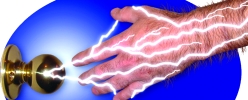Static eliminators used to remedy common static problems
July 2006
Pneumatics & Hydraulics

Static electricity causes problems when the temperature and humidity drops. The types of problems that can be expected in production facilities are:
* Materials tearing, jamming or curling.
* Webs and films clinging to themselves.
* Electronic sensors failing, thereby causing false readings.
* Dust attraction ruining surface finishes.
* Product clinging to itself, rollers and machine beds.
* Hazardous sparks or shocks.
Charged conductors, for example metals, discharge completely when grounded while insulators like plastic, do not conduct static electricity. The use of carbon brushes or grounded tinsel to ground machinery has little effect on these surfaces.
EXAIR manufactures a complete range of static eliminators to remedy common static problems. The Super Ion Air Knife, with its curtain of laminar airflow, is recommended for applications involving high speeds, large surfaces or complex geometries. It is effective up to 6 m. The manufacturer avers that it provides the best performance of all ionisers. Other static eliminators include the Air Cannon, the Ion Air Gun and the Ion Air Jet. The entire range use the manufacturer's engineered airflow products to minimise air use and noise while effectively eliminating static by moving more ions to the product surface.
In applications where airflow will possibly disturb the product, the manufacturer's Ionising Bars and Ionising Point can neutralise the charge when mounted within a couple of centimetres of the surface and do not require airflow.
It is often difficult to isolate the source of the static but EXAIR's handheld, digital Static Meter can be used to locate its source and severity. The meter indicates the surface voltage and polarity up to 20 kV measured at a distance of 25 mm. Features include a pushbutton 'hold' for readings and automatic 'power off'. It is supplied with a hard shell case and calibration certificate traceable to NIST (National Institute of Standards and Technology).
The Static Meter can also be used to demonstrate that an ioniser is functioning by first measuring the charge on the product surface with the meter, then exposing the product to the ionised airflow and finally measuring the charge on the product surface again. The ioniser is functioning properly if the charge reads 0 volts.
If the charge remains on the product surface, it should be verified that the ioniser is connected properly to a grounded power supply. It is also possible that the ioniser has become dirty, in which case, cleaning by scrubbing any dust and contaminants with a small brush is required. Cleaning with chemical is not recommended as some chemicals are conductive and create a conductive path from the emitter to the grounded surface. Flammability of certain solvents is also an issue.
For more information contact Rodney or Alan, ETEST, 031 702 8302, [email protected], www.etest.co.za
Further reading:
Robust sensors for pneumatic applications
ifm - South Africa
Pneumatics & Hydraulics
The pressure sensors from ifm have a G1/8 process connection, combined with a welded thin-film measuring cell. While offering an unbeatable price/performance ratio, this technology provides for high measuring accuracy in a very compact and robust housing.
Read more...
Seven years of uninterrupted service
Pneumatics & Hydraulics
A set of hydraulically operated Corflex pinch valves, installed in 2018 at a major North African gold mine, has delivered in one of the continent’s most demanding slurry-handling applications.
Read more...
Counterweight balancing in industrial robots
Pneumatics & Hydraulics
Hydraulics specialist, WEBER-HYDRAULIK is equipping KUKA robots with a hydraulic cylinder with an integrated pressure accumulator, which absorbs and balances the forces generated on the arm.
Read more...
How manufacturers achieve zero-leakage demands in hydraulic cylinders
Pneumatics & Hydraulics
Imagine a world where your hydraulic cylinders never leaked. The answer lies in a holistic approach that focuses on the fundamental components and their interactions, particularly the cylinder rod and its surrounding environment.
Read more...
The role of hydraulic systems in heavy machinery
Pneumatics & Hydraulics
In this article, we explore how hydraulic systems function, their role in powering heavy equipment, and why they are the preferred choice for industries requiring immense power and precision.
Read more...
Reliable, flexible and cost-effective rental compressed air
Pneumatics & Hydraulics
More businesses are turning to Integrated Air Solutions for rented on-demand compressed air, without the burden of capital expenditure.
Read more...
Axiom expands its hydraulic solutions with Powerstart piston accumulators
Axiom Hydraulics
Pneumatics & Hydraulics
Axiom is proud to announce a unique partnership with Powerworks, introducing a new generation of piston accumulators into the South African market, the Powerstart piston accumulators.
Read more...
Dynamic compressor control system with energy savings
Pneumatics & Hydraulics
CompAir has launched Ecoplant, a dynamic, compressed air management solution that adjusts compressor parameters in real time, offering up to 30 per cent reductions in energy costs and CO
2 emissions.
Read more...
Festo commits to a greener industrial future by driving sustainability and energy efficiency
Festo South Africa
Pneumatics & Hydraulics
As the world is facing significant ecological, social and economic challenges, Festo is taking proactive responsibility. Their goal is to contribute to a more sustainable future through the development of innovative technologies and responsible actions.
Read more...
Is your compressed air system sustainable?
Artic Driers International
Pneumatics & Hydraulics
We are all aware that compressed air is an expensive source of motive power, but do we actually know what the cost is?
Read more...


